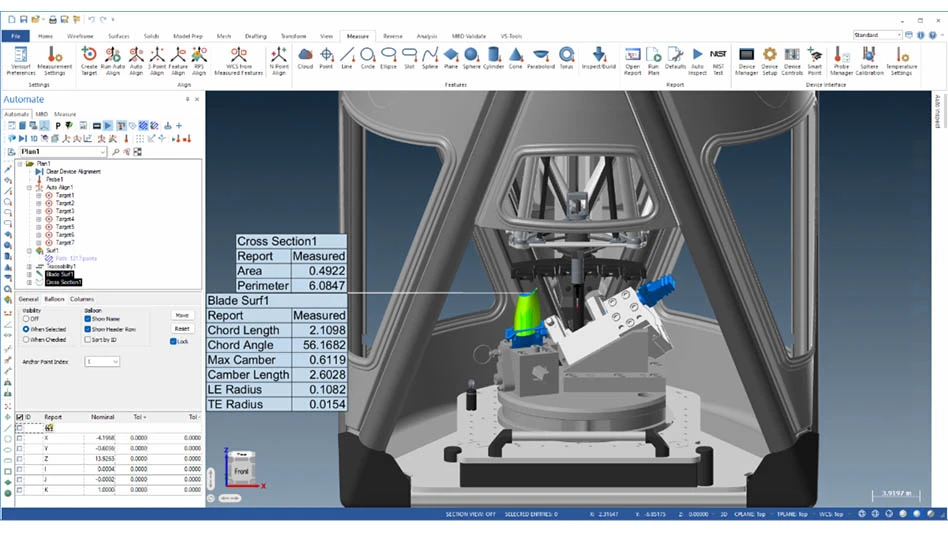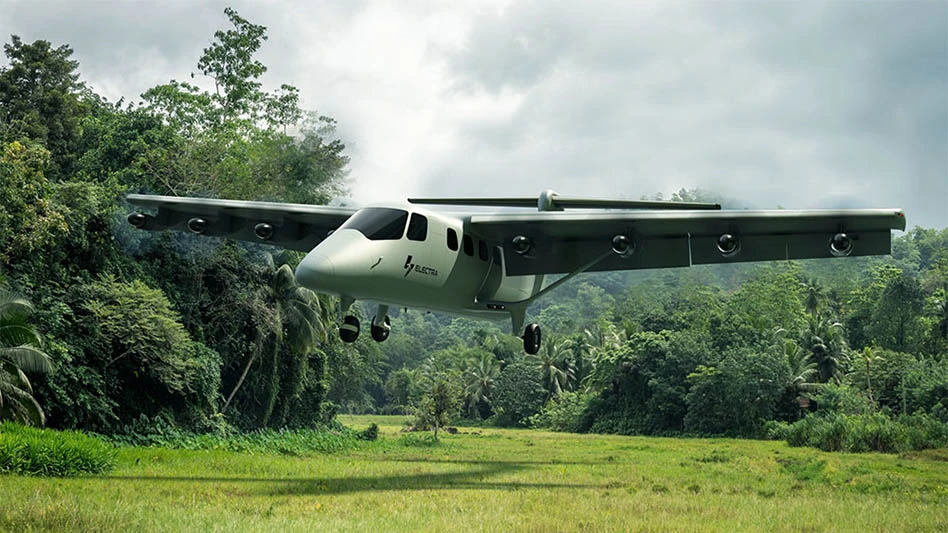
Imagine a sky filled with clean, green, energy-efficient jetliners, powered by electric motors or turbine-electric hybrid engines. Electric storage, distribution, and power technologies are still in their infancy, but recent developments point the way toward this dream.
The experimental Solar Impulse 2 (SI2) demonstrated that a solar-powered, electric aircraft could circumnavigate the Earth – but the slow-flying, high-aspect-ratio wing, single-person vehicle is not a practical model for future air transport. However, the engineering that helped develop SI2 has applications for mainstream airliners.
SI2 completed its journey around the world with the help of Dassault Systèmes’ 3DExperience design software – including the Catia, Enovia, and Delmia applications – for its fuselage, wings, and materials. The Solar Impulse team used 3D modeling of complex structures and composites, digital simulation, and full data traceability to experience the aircraft in its operating environment virtually before it flew.
Michel Tellier, vice president of aerospace and defense at Dassault Systèmes, describes the role software played in the Solar Impulse team’s success, saying, “From an engineering standpoint, the key parameters were optimizing the design for weight. That was a big deal because of the massive wingspan, and to be able to have enough solar cells on it to gather the energy they needed.”
After designing a lightweight structure, it was important to simulate the entire aircraft as a system with all its different components. Using 3DExperience applications for flight-systems integration simulation proved the design’s feasibility.
Managing the human occupant
“For SI2, the focus was on creating an environment where a pilot could live for six or seven days in an unpressurized cabin the size of a phone booth,” Tellier notes.
The flight profile included daily, large swings in temperature. SI2 flew in a long, sustained descent at night and then powered up during the day, charging batteries, and gaining altitude. Tellier says that to accommodate the pilot’s sleep cycles, bodily functions, and exercise needs, the cabin required “a seat that was at the same time a bed, a yoga pad, a flight deck, and a toilet all built into one.”
The process involved kinematics, ergonomics, dynamics, heating, oxygen, volume, area, and space management. The team designed the cockpit in 3D using precise, anthropomorphic software models that could measure fatigue, strain, repetitive stress, vision, and other phenomena.
“With those tools, they could life-cycle each pilot through the mission and optimize the flight deck accordingly, making the package reliable and light,” Tellier explains.
Understanding machine behavior
The round-the-world flight was predicated on having developed a clear understanding of how the machine would behave in a variety of environmental conditions. Software defined a system of systems, integrated in a behavioral model. For example, battery suppliers provided data on battery performance that was integrated into simulation of the control systems, structures, and aerodynamics.
“We were orchestrating all of the different simulations into one,” Tellier says. “Batteries on load from motors, the charge and discharge rate, temperature, amps, voltage.”
By integrating battery data with models of motors, controls, communications, lighting, heating, and power systems, the team could then simulate the flight and use the data to manage the condition of the batteries during flight.
“The flight validates that the simulation has properly described what is happening physically,” Tellier notes. “Your ability to manage the fidelity between the virtual and actual world is what it’s all about.”

Risk mitigation
Flying over the Pacific Ocean for seven days with no backup systems is dangerous, so another focus of SI2’s flight was on risk mitigation.
“The best means we had to mitigate risk was to massively simulate design, performance, and operation,” Tellier says. “You can’t just take away design elements for weight or add design elements for safety without understanding their impact.”
The tight envelope on safety and performance required data traceability, consistency, and structure.
“That kind of product-life- cycle-management (PLM)-based traceability throughout the whole development process is essential,” Tellier says. “You get a high degree of visibility on why every element is there and the impact of changing any one thing.”
The future
In the past, 20 to 30 software vendors and a systems integrator had to collaborate to make all the software simulations work together – something only the largest original equipment manufacturers (OEMs) could do. The SI2 experience taught Dassault Systèmes engineers a lesson in making their technology widespread, useable, and affordable.
“It was interesting to see if we were succeeding in making the state-of-the-art available to small operations,” Tellier explains. “The Solar Impulse team did amazing feats of engineering with a small crew, and the results are proven by the success of their mission.”
Tellier calls it the democratization of the technology. It’s no longer necessary to be part of a major OEM to be state of the art. If you have an idea, you can explore it; you don’t need to have a huge mainframe computer, servers, and information technology (IT) staff.
“Here’s a mission with explorers with limited means and limited capacity, undertaking a gigantic challenge,” Tellier observes. The Solar Impulse team had to approach the aircraft’s development with the idea: “You really want to simulate the heck out of it, because you can’t afford to iterate the design.” It’s also financially prohibitive to have an exhaustive flight test program to find out what didn’t work and redesign it. “They had to get it right the first time.”
Tellier cites another example of the future – Joby Aviation, in California’s Silicon Valley, a small team of designers developing what they hope will be the next generation of personal transport using science from NASA and their own motor designs.
“They are doing some very nice engineering,” Tellier says. “The level of sophistication to which they are using our technology is impressive.”
They’re using the 3DExperience aerospace solution on the cloud.
“Ten years ago, I wasn’t dreaming we’d be doing what we’re doing now,” Tellier explains. “They rent specific capability for the number of people who use it, for the time they use it. By massively shrink-wrapping their usage, we can drive significant economies and make it affordable to them.”
Further electrification
SI2 is the most globally recognized success for new zero-emission aircraft technology, a direction some well-known players are looking to take commercial aviation. Airbus has its E-Fan initiative, which has grown from a small twin-engine, all-electric aircraft in two versions into a more ambitious, hybrid electric-thermal propulsion airplane, the E-Fan Plus.
By advancing the E-Fan demonstrator, Airbus and its partners are hoping to reduce CO2 emissions 75% per passenger kilometer, reduce NOX emissions 90%, and reduce noise by 65% as a step toward the European Commission’s Flightpath 2050 environmental protection goals for the air transport industry.
In April 2016, Siemens and Airbus agreed to drive the development of electrically powered flight. Siemens and Airbus will be using the record-setting motor as a basis for developing regional airliners powered by hybrid-electric propulsion systems.
“By 2030, we expect to see initial aircraft with up to 100 passengers and a range of around 1,000km,” says Frank Anton, head of eAircraft at Siemens’ corporate technology central research unit.
Making aircraft electric or hybrid simplifies them, Tellier says. “On traditional aircraft, we have hydraulic, air-driven, and electrical systems piggybacked on one another, all running in triple redundancy. If you move everything to electrical, you are significantly simplifying the architecture. As soon as we get through milestones on weight, capacitance, and batteries, we’re probably going to see an adoption rate that’s going to be very quick because it makes flight easier.”
Dassault Systèmes Aerospace and Defense
About the author: Eric Brother, senior editor of AM&D, can be reached at 216.393.0228 or ebrothers@gie.net.

Explore the April May 2017 Issue
Check out more from this issue and find your next story to read.
Latest from Aerospace Manufacturing and Design
- Simplify your shop floor operations while ensuring quality parts
- Happy Independence Day - July 4th
- Bombardier receives firm order for 50 Challenger, Global jets
- Automatic miter bandsaw
- SAS orders 45 Embraer E2 jets with options for 10 more
- Height measuring instrument
- Shopfloor Connectivity Roundtable with Renishaw & SMW Autoblok
- Moog expands space actuation, avionics manufacturing





